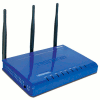- Qualcomm Launches Snapdragon 4 Gen 2 Mobile Platform
- AMD Launches Ryzen PRO 7000 Series Mobile & Desktop Platform
- Intel Launches Sleek Single-Slot Arc Pro A60 Workstation Graphics Card
- NVIDIA Announces Latest Ada Lovelace Additions: GeForce RTX 4060 Ti & RTX 4060
- Maxon Redshift With AMD Radeon GPU Rendering Support Now Available
TRENDnet TEW-631BRP Wireless N Router

Looking to move up to Draft N wireless but don’t want to spend a fortune? TRENDnet has a $70 solution for you, in the form of the TEW-631BRP. Despite it’s budget price and bright blue hue, the router turns out to be a great offering.
Page 3 – Testing, Final Thoughts
As in our other router tests, we take a real world approach in our methodology. We have a simple 600 MB file that we transfer across the network both using the Wireless N 621PC from TRENDnet as well as the built in 802.11g adapter in our test notebook.
Our goal in this test is to showcase the difference between using a Draft N connection and the more common 11g. It should also be pointed out that the theoretical limit of Draft N is a staggering 300 Mbps while the 11g protocol is much slower at 54 Mbps. Keep in mind though, these are theoretical speeds and you will assuredly never see speeds such as this any time soon.
The machines used in our test were:
- Test Notebook
- IBM Thinkpad T42
- Intel Pentium-M 1.5 GHz CPU
- 512MB DDR RAM
- ATI Mobility Radeon 7500
- Integrated Gigabit Ethernet
- Windows XP Pro 32-Bit
- Test Desktop
- IBM NetVista
- Intel Pentium 4 2.66 GHz CPU
- 1GB DDR RAM
- ATI 9800 XT
- Integrated Gigabit Ethernet
- Windows XP Pro 32-Bit
As in our Actiontec MegaPlug AV 200 review, the machines used have stayed the same. Again, we transferred our image file three times in each test. Three times from the notebook to the desktop and then three times from the desktop back to the notebook. This was done for both 11n and 11g connection speeds.

As the graph indicates, the Draft N performance was twice that of the 11g. While this is impressive, it’s expected. With performance in mind, speed in only one of the added advantages of using Draft N hardware. The second is range. Heralded as a double in range, the Draft N protocol should prove to be powerful enough for me to roam around the building, testing out whether or not we had a signal on our notebook.
In my venture, I was able to get all the way out of the building with Draft N but halfway down the drive as well. When we tried this same approach when connected to the 11g signal, we were able to get just over half the distance of 11n. While again, not surprising, the range of N is clearly stronger, giving access to more areas of a home than that of G.
Final Thoughts
When looking back over our experience with the TEW-631BRP, the most important thing that we kept coming back to was the price. Intending to compete with the bigger home networking companies here in the states, the TEW-631BRP can be found online for around 65 dollars. Clearly these are priced to sell and in talks with TRENDnet, they have moved a lot of them into the retail channel… encouraging news indeed.
The performance of the TEW-631BRP was solid as well when compared to that of a regular 802.11g connection. In the coming week, we will be releasing our review of TRENDnet’s flagship router, the TEW-633GR gaming router. This router included 4 gigabit ports on the back and is positioned quite well to compete with the D-Link DIR-633. We have been examining the performance differences between both TRENDnet routers as well the D-Link so stay tuned.

Getting back to the TEW-631BRP, it’s priced so well that it might make sense for many to upgrade that old 11g router you have at your house to a router such as this one from TRENDnet. In all honesty, this seems to be where TRENDnet is aiming their pricing scheme.
The more homes they can get their products in the better and for those in the market for a simple and easy to use Wireless N router (regardless of how ugly it actually might be), the TEW-631BRP from TRENDnet should get your consideration on your list of routers to look at. For the price and performance, the TRENDnet TEW-631BRP earns an 8 out of 10.
- Pros
- Small
- Draft N 2.0 compliant
- Full feature set
- Simple to use
- On/Off switch for WLAN
- Cheap!
- Cons
- Kind of ugly… personal preference
- Wired ports are still 10/100

|
|
Support our efforts! With ad revenue at an all-time low for written websites, we're relying more than ever on reader support to help us continue putting so much effort into this type of content. You can support us by becoming a Patron, or by using our Amazon shopping affiliate links listed through our articles. Thanks for your support!




